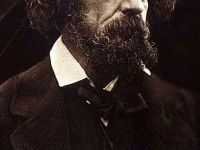Victorian Poetry with Alfred Lord Tennyson
On August 6, 1809, one of the most important English poets of the Victorian era was born, Alfred Lord Tennyson. The works of Alfred Lord Tennyson are best known for their close affinity with the English mythology and English history, they influenced the movement of the 19th century’s Victorian Art as well as the Arts and Crafts Movement, which was to join art and handcraft using simple forms applied to mostly romantic…
Read more











